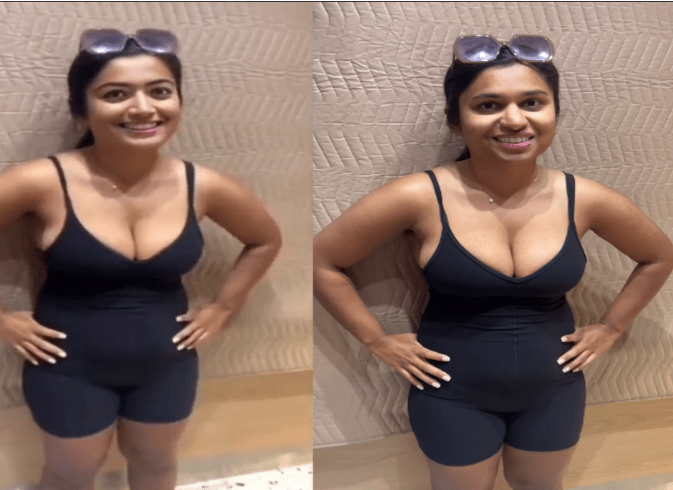Rashmika Mandanna Deepfake: Deepfake videos are produced through machine learning algorithms that meticulously analyze numerous face shots. These algorithms selectively choose the most suitable face to replace someone’s original appearance.
Rashmika Mandanna Deepfake is on the News
A viral deepfake video featuring actress Rashmika Mandanna has taken the internet by storm. The clip showcases Ms. Mandanna stepping into an elevator. However, fellow actors and users on social media platforms like X (formerly Twitter) were quick to identify the video as digitally manipulated. The video left actor Amitabh Bachchan in disbelief, who called for legal action, and even caught the attention of Union Minister Rajeev Chandrashekhar. The level of manipulation in the video is so intricate that distinguishing the imposter from the real Ms. Mandanna becomes incredibly challenging.
Rashmika Mandanna Deepfake Video
What is deepfake AI?
Deepfake AI refers to an advanced form of artificial intelligence that skillfully fabricates compelling images, audio, and video in the realm of hoax creation. This term encompasses not only the groundbreaking technology itself but also encompasses the deceptive content it produces. Coined as a portmanteau of “deep learning” and “fake,” deepfake AI stands as a testament to the fusion of sophisticated intelligence and the realm of fabricated imagery.
Deepakes frequently manipulate existing source material by replacing one person with another or generating entirely new content that portrays someone doing or saying things they never did or said.
As Tech Target, deepfakes involve altering original source content by replacing one person’s face with another. In this instance, the face of Ms Mandanna has been substituted with that of Zara Patel, a British-Indian woman.
These are also employed to craft unique content, portraying individuals doing or saying things they did not actually do or say.
How are they made?
In 2017, Reddit unveiled a groundbreaking discovery: the emergence of deepfake videos on a wide scale. These deceptive creations featured the faces of famous individuals, including Gal Gadot, Taylor Swift, Scarlett Johansson, and more, cleverly manipulated into explicit content.
These videos are produced by machines using advanced deep-learning algorithms. By employing an AI encoder algorithm, these machines analyze multiple facial shots to identify similarities and extract their shared features. The primary goal of this process is to compress the images while preserving their essential characteristics.
The encoder proceeds by inputting an incorrect image to the source, while the decoder algorithm reconstructs the face with its corresponding expressions and orientation. Enhancing both the writing quality and readability while still preserving the original meaning.
How do deepfakes work?
Deepfakes utilize a pair of algorithms – a generator and a discriminator – to formulate and refine fabricated content. The generator assembles a training dataset based on the desired output, generating the initial artificial digital content. Meanwhile, the discriminator assesses the authenticity of the initial version by scrutinizing its realism. This iterative process empowers the generator to improve its ability to produce genuine content while enabling the discriminator to adeptly identify flaws for the generator to rectify.
A generative adversarial network (GAN) is formed by combining generator and discriminator algorithms. GANs, powered by deep learning, can discern patterns in real images and utilize them to generate convincing fakes.
There are two primary methods of creating deepfake videos. The first involves utilizing an original video of the target, manipulating their actions and words to portray events that never occurred. The second method involves seamlessly replacing an individual’s face with that of another person, commonly referred to as a face swap.
How are deepfakes commonly used?
Rashmika Mandanna Deepfake is a recent example of the usage of Deepfake AI. Deepfake videos have predominantly been pornographic. However, during elections, digitally manipulated clips of politicians circulate to falsely attribute statements or promises to them.
The use of deepfakes varies significantly. The main uses include the following:
- Art. Deepfake app have emerged as a remarkable tool for creating new music by leveraging the existing repertoire of an artist. rk.
- Deepfake Porn, Blackmail and reputation harm. Instances of this occur when a target image is manipulated to place someone in an unlawful, inappropriate, or compromising scenario. Examples include disseminating false information, engaging in explicit sexual acts, or involvement in illicit substances. These videos serve as a means to extort, tarnish a person’s reputation, seek retribution, or partake in cyberbullying. Of these, the most prevalent form of exploitation is the nonconsensual creation of deepfake pornography, commonly known as revenge porn.
- Caller response services. These utilize deepfakes to deliver personalized responses for caller requests that encompass call forwarding and other receptionist services.
- Customer phone support. These utilize artificial voices to perform basic tasks like checking account balances or registering complaints.
- Entertainment. H movies and video games employ voice cloning and manipulation techniques for specific scenes. These entertainment mediums utilize this technology when shooting becomes challenging, during post-production when an actor is unavailable to record their voice, or simply to streamline the production process. Deepfakes, on the other hand, find their place in satire and parody content, creating an amusing scenario despite the clear understanding of their non-authentic nature. Case in point, the 2023 deepfake featuring Dwayne “The Rock” Johnson hilariously transformed into Dora the Explorer.
- False evidence. This entails the creation of fraudulent visual or auditory content, which may serve as evidence suggesting culpability or innocence in a legal matter.
- Fraud. Deepfakes are maliciously employed to impersonate individuals, with the goal of surreptitiously acquiring their personally identifiable information (PII), including sensitive data like bank account and credit card numbers. This nefarious tactic may even involve mimicking high-ranking executives or other employees possessing credentials to access confidential information, thus posing a significant cybersecurity risk.
- Misinformation and political manipulation. The utilization of deepfake videos featuring politicians or reliable figures is deployed with the intent to manipulate public perception. A prime example of this tactic is the deepfake involving Ukrainian President Volodomyr Zelenskyy, which serves to engender chaos within the context of warfare. This technique is commonly referred to as the dissemination of fabricated information.
- Stock manipulation. Manipulated deepfake content is utilized to manipulate the stock price of companies. As an example, a fabricated video of a CEO making detrimental remarks about their own company could cause a decline in its stock value. Conversely, a fabricated video highlighting a technological breakthrough or product launch could potentially amplify a company’s stock price.
- Texting. According to the “Increasing Threat of Deepfake Identities” report by the U.S. Department of Homeland Security, text messaging is identified as a potential future application of deepfake technology. The report suggests that threat actors could exploit deepfake techniques to imitate a user’s texting style.
Are deepfakes legal?
Although deepfakes present significant threats, they are typically legal, leaving law enforcement with limited options for intervention. Deepfakes only become illegal when they contravene existing laws, such as those prohibiting child pornography, defamation, or hate speech.
Deepfake laws exist in three states. Texas prohibits deepfakes intended to sway elections, while Virginia bans the distribution of deepfake pornography. In California, laws are in place to prevent the use of political deepfakes within 60 days of an election and the circulation of nonconsensual deepfake pornography.
The absence of regulations governing deepfakes can be attributed to a general lack of awareness among the masses regarding this emerging technology, its applications, and associated risks. Consequently, victims often find themselves without legal protection in the majority of deepfake cases.
How are deepfakes dangerous?
Despite their legality, deepfakes present significant risks and potential harm. These dangers include, but are not limited to, the following factors:
- Blackmail and damage to one’s reputation can lead to legal vulnerabilities for targeted individuals.
- Political misinformation is often exploited by nation states’ threat actors for nefarious purposes.
- One form of election interference involves fabricating counterfeit videos featuring candidates, thereby misleading the public.
- Stock manipulation involves the creation of fabricated content with the intent to influence stock prices.
- Impersonation fraud involves stealing financial accounts and other personally identifiable information (PII) by pretending to be someone else.
Methods to detecting deepfakes
Detectfake attacks involves following several effective practices. The presence of the following signs may indicate the presence of deepfake content:
- Unusual or awkward facial positioning.
- Unnatural body movement.
- Unnatural Coloring in the Video
- Videos that appear peculiar or distorted when zoomed in or magnified.
- Inconsistent audio.
- People that don’t blink.
There are a few telltale signs or indicators that can help identify textual deep fakes:
- Misspellings.
- Sentences that don’t flow naturally.
- Suspicious source email addresses.
- Phrasing that doesn’t match the supposed sender.
- Messages lacking context and relevance to ongoing discussions, events, or issues.
However, AI is steadily overcoming some of these indicators, such as with tools that support natural blinking.
Examples of deepfake
Numer remarkable instances of deepfakes exist, encompassing the following:
- Facebook founder Mark Zuckerberg was the victim of a deepfake that showed him boasting about how Facebook “owns” its users. The video was designed to show how people can use social media platforms such as Facebook to deceive the public.
- U.S. President Joe Biden was the victim of numerous deepfakes in 2020 showing him in exaggerated states of cognitive decline meant to influence the presidential election. Presidents Barack Obama and Donald Trump have also been victims of deepfake videos, some to spread disinformation and some as satire and entertainment.
- During the Russian invasion of Ukraine in 2022, Ukrainian President Volodomyr Zelenskyy was portrayed telling his troops to surrender to the Russians.
- Samantha Deepfake: A recent Bold Viral Video of Indian well known actress Rashmika Mandanna where in British-Indian lady was entering into lift.
- Jenna Ortega Deepfake: She has become the target of a disturbing online trend of Deepfake in May2023

